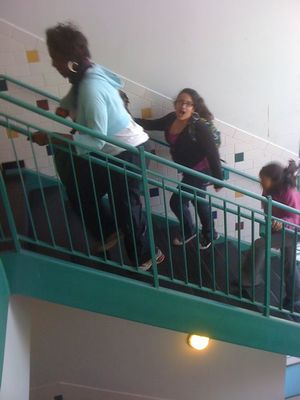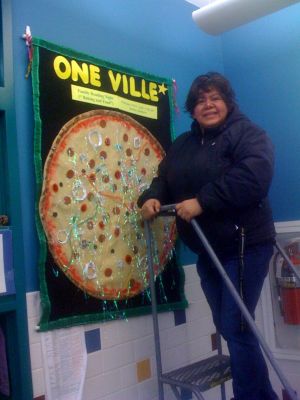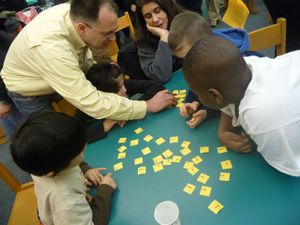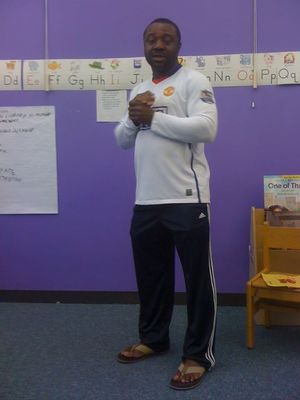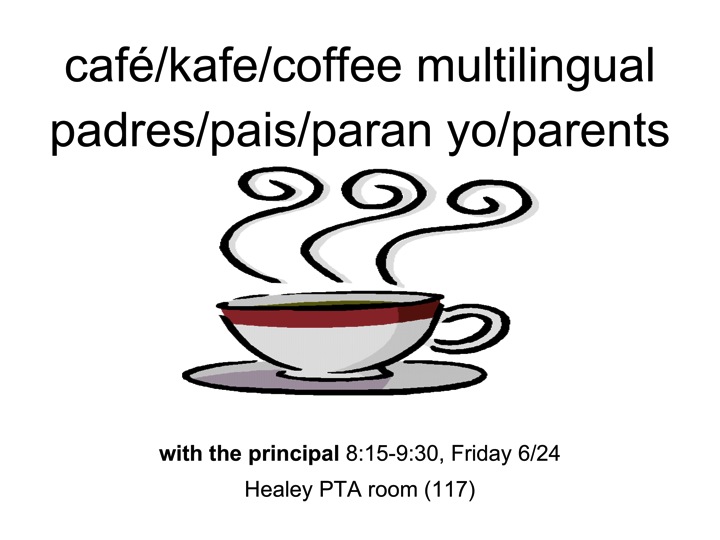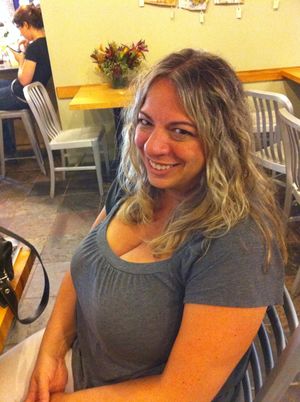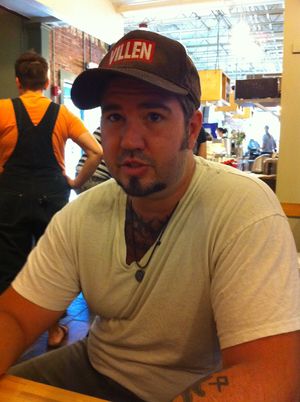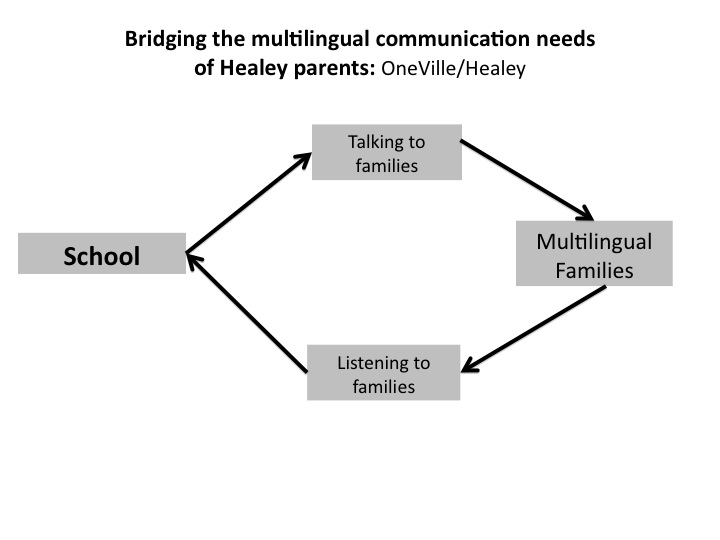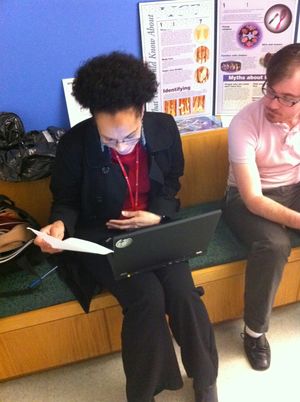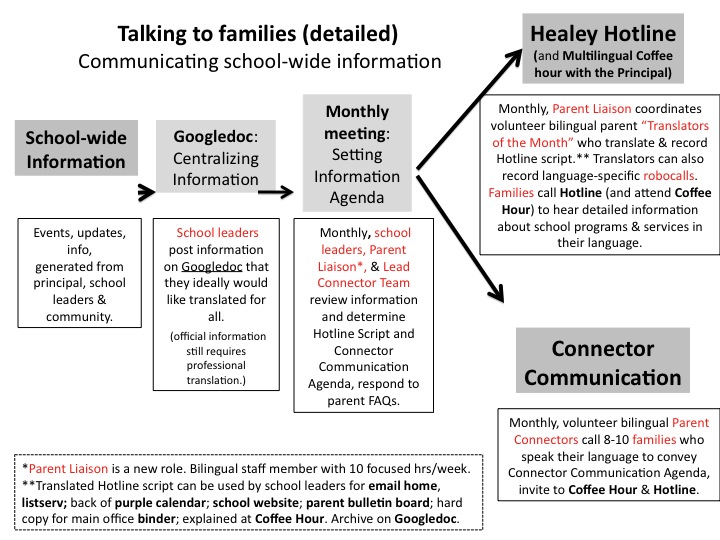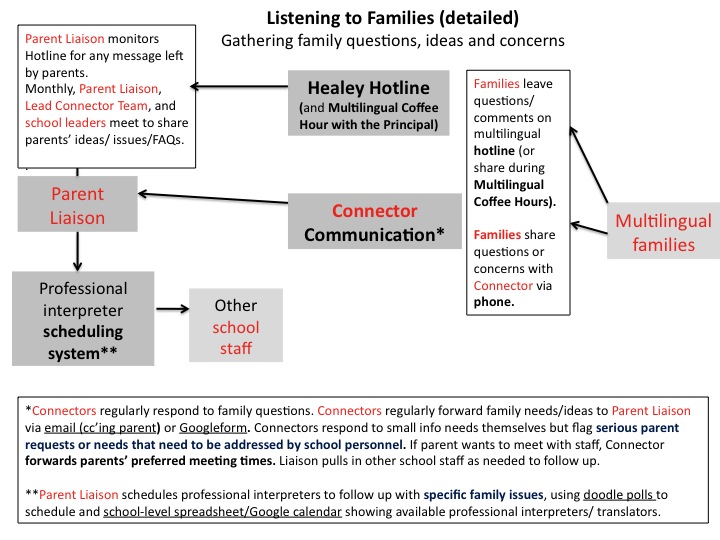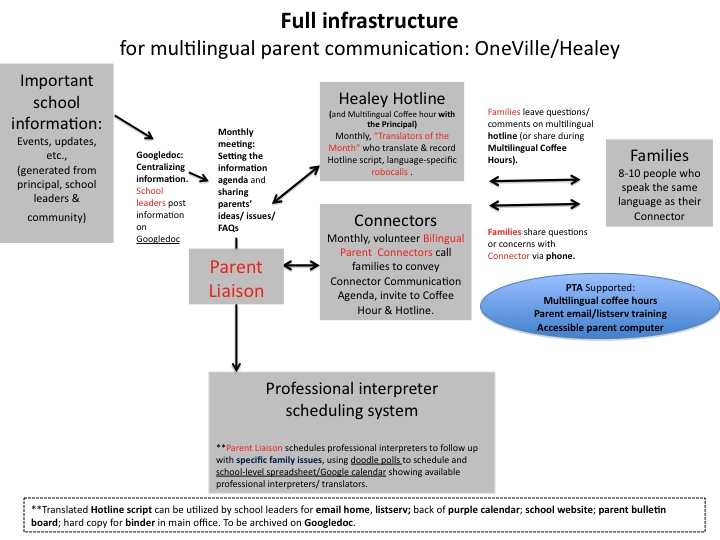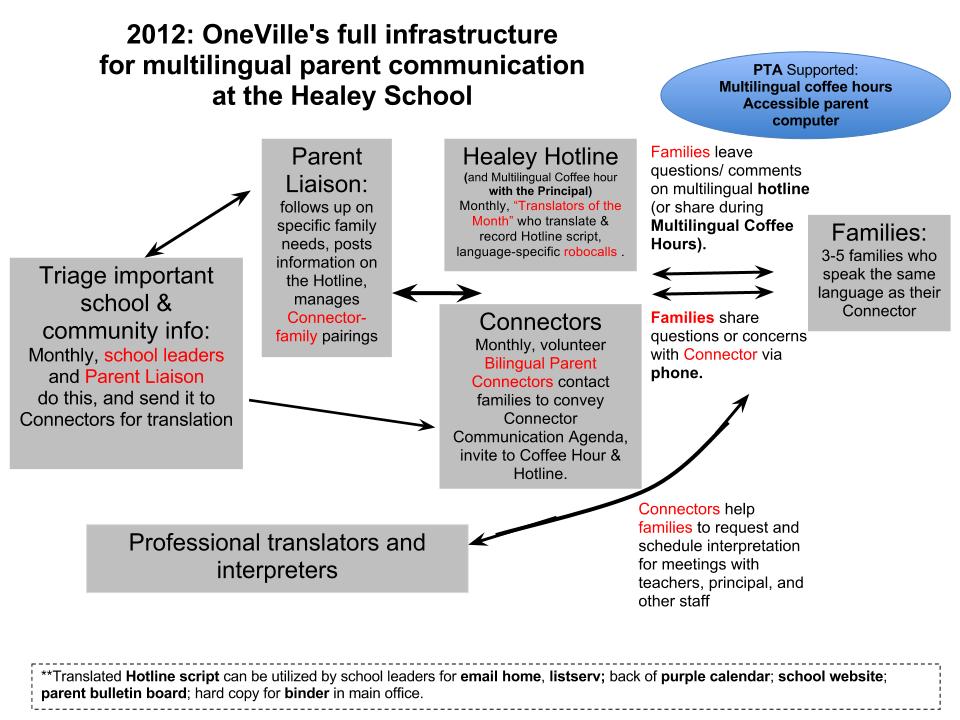Expanded story: Schoolwide toolkit/parent connector network: Difference between revisions
From Oneville Wiki
| Line 232: | Line 232: | ||
* '''Email training: '''Our vision for youth and parent computer and email training was that the computer could be a doorway to meeting a wide range of family needs, from adult job searching and literacy development to youth development as teachers for adults. While we didn't have the capacity to build on proven local models for computer training, we're hopeful that the school and community organizations can partner on this issue in the future. | * '''Email training: '''Our vision for youth and parent computer and email training was that the computer could be a doorway to meeting a wide range of family needs, from adult job searching and literacy development to youth development as teachers for adults. While we didn't have the capacity to build on proven local models for computer training, we're hopeful that the school and community organizations can partner on this issue in the future. | ||
[[Image: | [[Image:Revisedinfrastructure*.jpg|Revisedinfrastructure*.jpg]] | ||
'''<font color=red>¡Aha!</font color> Some key documents can be translated once, for repeated use.''' | '''<font color=red>¡Aha!</font color> Some key documents can be translated once, for repeated use.''' | ||
Revision as of 16:31, 15 July 2012
Written by Mica Pollock, Tona Delmonico, Gina d'Haiti, and Ana Maria Nieto for the Parent Connector project, with input from parents across the Healey School and Jedd Cohen.
Click here for the Summary on this project; click here for the Overview and key findings on this project.
The Details of the Work
The expanded story behind our efforts, our communication and implementation ¡Ahas!, and our turning points!
In 2009 when we began our work, the K-8 Healey had 4 historically separated programs: a magnet K-6 program drawing disproportionately middle-class families from Somerville; a "Neighborhood" K-6 program disproportionately enrolling low income and immigrant families living around the school, including in the housing development a few steps away; a Special Education program, also disproportionately enrolling low income students of color and immigrants; and a middle school (7-8).
In fall 2009, with parents from across the first three programs whose children shared a Kindergarten hallway at the Healey, we began creating Reading Nights to link parents in face to face efforts to build relationships and share information on reading with young children.
Several of these parents formed the early core of the parents who would continue to work on schoolwide communication for two straight years. We worked together on creating a monthly multilingual coffee hour and holding some parent dialogues. In 2010-11, a subset of bilingual parents forged forward to create the Parent Connector Network.
From the beginning, we wrestled with the particular issue of connecting English-speaking parents and staff with parents speaking other languages -- and with getting information written in English translated. Over time, we realized the particular need for improving the communication infrastructure for translation and interpretation and focused fully on the Parent Connector Network in winter/spring 2011. But let us share the story of how we got there! It's a story of friendships sparking school improvements and vice versa.
SCHOOLWIDE COMMUNICATION EFFORT 1: READING NIGHT
In fall 2009, Mica and Consuelo, both parents in the Kindergarten hallway at the Healey School, met at a parent coffee hour with the principal and discovered a mutual interest in starting conversations across language and program. We immediately started talking to other parents about the idea of “OneVille” -- in this case, linking families who shared a diverse school divided across several programs. With that, a design partnership at the Healey began to sprout.
In conversations with the principal and other parents in the hallway, we came up with the idea of holding a monthly Reading Night designed to link parents across programs in communications about supporting children’s literacy. We sat with other parents in the PTA room and talked about what might pull us together. Tracy and Dave, Maria, Jen, Carrie, Consuelo, Michelle, and others started brainstorming a first Reading Night focused on baking words. (Tracy, a parent in the hallway’s “Neighborhood” classroom, had a cookie business and her husband Dave worked in a pizza restaurant.)
In doing the work of holding Reading Nights, we built friendships between us parents that would make a difference in the years to come -- and we encountered a number of schoolwide communication issues that would shape our thinking about the “infrastructure” for including parents that was needed at the Healey.
¡Aha! the success of any school event relies on school-home communication, and in that, parent-parent communication can be the key.
To get parents in the hallway out to Reading Nights, we had to advertise events in multiple languages and test ways of getting people back to school in the evenings. A listserv linked the school’s K-6 magnet program parents (though less so, the program’s lower-income and recent immigrant parents) but not the parents of children enrolled in the school's Special Education and "Neighborhood" programs. To include everyone, we moved forward with paper and face to face communication.
We put up multilingual signs outside of the classroom doors, where parents would see them. Some did, but not all parents dropped off their kids at school themselves. Consuelo's giant pizza, put up on the wall a few days before each Reading Night, worked particularly well to attract kids -- who then brought their parents.
Had we known that we could record calls on the school's "robocall" system (ConnectEd) to target parents in their language, perhaps we could have used that to invite more people. It wasn't until the following year, with a new principal, that we realized parents themselves could help shape the content of robocalls by asking the principal to record strategic calls out to all parents. This most direct channel-home was typically used only for the "most important" of communications. We only used the robocall system several times in these first two years -- to invite people to a schoolwide dialogue and to invite parents to PTA night events.)
Face to face invitations on the playground before school were often the thing that brought some parents to Reading Night. But face-to-face invitations were really time-consuming, and our energy for standing outside to invite parents personally to events waned over the year. Beyond sending fliers home and putting up Consuelo’s pizza, at teachers’ urging we continued to announce Reading Nights to kids in classrooms, who would then invite their parents. After dozens of families from the four classrooms attended our first launch Reading Night, one of our most well-attended Reading Nights involved an entire “Neighborhood” class, who did a play together with their teacher. After initial curiosity about the Reading Nights, parents definitely kept coming out at night to see their own children or child's teacher (or, to see friends they had made in earlier events).
¡Aha! Sharing info and building relationships with busy parents often requires face to face contact, despite the fact that it’s time-consuming.
¡Aha! Bringing kids along to parent events helps glue together parents in a common experience -- even as it also distracts them from sharing information with other parents!
Reading Nights were in part about getting families excited about reading together in new ways (parents told us their children left talking all night about reading). But as it turned out, what many parents most needed (or wanted!) was a chance to talk quietly to other parents. We learned to make time in Reading Nights to get parents together on the side to talk together about our children’s reading struggles, as our children did activities. (This required parents who could interpret for others.) In part from listening to parents who ended up chaperoning the kids, missing the parent-to-parent conversation, and getting frustrated, we realized parents really needed opportunities to share common experiences and, to make friends.
As we tried to share out tips from Reading Nights, though, we again realized the need for better communication infrastructure for connecting parents to each other to share information. We tried to post our reading tips as paper sheets on a hallway bulletin board (we used Google Translate, which garbled some of the words) and we stuck these same translated fliers in every backpack. But backpack handouts never turned into a conversation that ran in between our Reading Nights -- whoever didn’t come in person didn’t really benefit, either from the information shared that night or, from the relationship-building.
¡Aha! There’s no way that all parents will or can show up to face-to-face events. So, any event needs a plan for connecting next to parents who didn’t show up.
A next issue arose: prepping for Reading Night took more time than we wanted, because we tended to prepare materials from scratch.
But at the same time, we knew that kids loved the events, and the work did create friends and leaders among us. One organizing parent (Maria) later became the head of the PTA and two others (Tracy and Dave) its vice presidents, and others (Michelle) won spots on the School Site Council in a year that would turn out to be very important for the Healey’s future (see below). We saw other benefits to parent-parent connections: since our first Reading Night focused on sharing words about baking, one mom (Carrie) got word of Tracy’s cookie business -- and hooked her up to a reporter in the Boston Globe for press.
We burned out on Reading Night after holding about six of them that year, because it took too much face to face work to create materials from scratch. In a sense, we reached the outer limit of volunteer time and energy. We also realized that since we weren’t experts on reading, it was more effective for us to focus on venues for gathering parents to talk, period, than on guiding other parents in the content of teaching reading. We also didn’t yet know how to “seed” events so they would replicate without us. But we knew we had created an important space for parents to gather together -- and the friendships we made carried us through our next innovations.
¡Aha! If prepping face to face events from scratch takes too much volunteer time from people, they lose momentum. At the same time, the slog of preparing for face to face events can build friendships that can seed real change.
SCHOOLWIDE COMMUNICATION EFFORT 2: MULTILINGUAL COFFEE HOUR
While designing Reading Nights, we also focused on improving an existing "slot" for parent-parent and parent-administrator communication: the typically English-dominated "coffee hours" with the principal, held monthly on Friday mornings in the PTA room. Relatively few immigrant parents came regularly to this event, and English-speaking parents almost always dominated the conversation.
In partnership with the principal in fall 2009, we created a slot for a multilingual coffee hour model, a brainstorm of Consuelo, always committed to finding creative ways of empowering and including immigrant parents. We thought about having language-specific coffee hours, an idea we still find important, but the principal asked for a combined coffee hour, which in the end offered its own benefit -- valuing multilingualism. In the multilingual coffee hour, parents voluntarily translated for other parents wanting to ask questions and hear information from the principal. Enjoying the sound and skills of multiple languages became part of the event.
The experience quickly clued us into a key local resource:
¡Aha! The massive local resource of parent bilingualism!
At several points over that school year and the next, we considered combining the multilingual coffee hour back into the "regular" coffee hour with the principal. In fall 2010, the Healey's next principal first suggested that every coffee hour should de facto be multilingual. But, then he decided to keep a distinct "multilingual" coffee hour. Since typical coffee hours were still dominated by questions and rapidly-launched comments from English-speaking parents, it still felt important to have a space focused actively on multilingual communication. The multilingual coffee hour with the principal is now an established place where people take extra time for translation and purposefully amplify languages other than English, by ensuring that speakers of other languages get priority in asking and answering questions. Main needs: a coffee pot; some Brazilian sweet bread; the principal; and parents with questions or ideas.
¡Aha! Making parent gatherings explicitly multilingual encourages speakers of languages other than English to ask questions and offer opinions. It also encourages participants to explicitly value other parents' language skills.
SCHOOLWIDE COMMUNICATION EFFORT 3: PARENT-PARENT ISSUE DIALOGUES
New community developments at the Healey in 2009-10 shaped our next ahas about needed improvements to communication infrastructure. Halfway into the 2009-10 school year, the Somerville School Committee put on its agenda a key task: deciding whether to integrate the Healey's magnet and "Neighborhood" K-6 programs. In response, we used our multilingual coffee hour for a number of parent dialogues and “Q and A with the principal” dialogues to facilitate conversation about this choice. (http://oneville.org/future-of-the-healey-frequently-asked-questions-and-their-answers/; http://oneville.org/21st-century-parent-dialogues/) We also held an organized parent dialogue on a Saturday at the nearby Mystic Housing Development’s activity center (http://oneville.org/oneville-report-from-parent-forum-at-mystic-center-may-1-2010/)
In our work to support such organized parent dialogues, we realized how irregular it was for parents to just speak to each other across "groups" about their children's education. Many parents had never talked to parents from the other programs, or across lines of language or social class.
¡Aha! Many parents have few or no opportunities to talk to each other or to decisionmakers in organized settings, about major issues in their school. This means that their ideas and energy for improvement go untapped.
It became important later in the Healey's unification debate to be able to report that everyone we talked to - across lines of class, race/ethnicity, and language - said they wanted a more rigorous learning experience for their children. In particular, many middle-class parents hadn't heard much about the aspirations and concerns of their recent immigrant or lower-income peers.
In the parent dialogue work, we also realized again some structural barriers of communication that held back many parents from being fully involved in the school. School committee members used the magnet program's listserv to advertise school committee meetings about the Unification debate. The parents who came to the meetings to speak their minds were disproportionately those on the listserv. Those on the listserv also emailed the superintendent or principal regularly with their opinions about whether the programs should integrate. Three months into the debate, when we walked around the nearby Mystic Development (the housing project literally down a flight of stairs from the school) to invite parents to a school committee meeting on the upcoming decision, we realized that many parents – again, those not on the listserv -- were unaware that the possibility of integration was even up for debate at their school at all. Some parents, particularly immigrant parents struggling to communicate in a new language, were so “out of the loop” of school information that they didn’t understand there were multiple programs at the school to begin with.
¡Aha! If tech channels for dialogue are available only to some in a school, those not on the channel don’t get equal access to the dialogue. (Example: a listserv that only some parents are on.)
In the end, the School Committee voted to "unify" the Healey's K-6 programs and hired a consultant to steer that process through the following school year. Parents were invited into the process as partners.
TURNING POINT: With the Healey in the midst of brainstorming all sorts of changes to its everyday structures, we parents focused for 2010-11 on improving infrastructure for schoolwide communication -- and on including immigrant parents in particular, through strengthening mechanisms for multilingual translation, interpretation, and conversation.
MAIN SCHOOLWIDE COMMUNICATION EFFORT: THE PARENT CONNECTOR NETWORK
In the cafeteria one morning in fall 2010, Consuelo and Mica were sitting with several parents from the PTA (Maria and others), talking about how to improve schoolwide communication. Consuelo, whose phone was constantly ringing with calls from Spanish-speaking parents with questions and needs (how to get a wheelchair? How to deal with a social service organization? Where to get a public service?) took out a piece of paper and started to draw triangles, linked to other triangles in a pyramid structure. Parents could be links to other parents, she explained, just as she was. In the car together going home, Mica named the role: "Connectors."
¡Aha! Parents can be organized as communication links --”connectors” -- to other parents.
We began to share out the basic idea of “parents linking to other parents” with the school council and other school leaders, to see what people thought of it. People immediately liked the idea: many Healey parents often spoke of the need for better translation of information and “inclusion” of immigrant parents but hadn’t been sure how to facilitate it. There were already "room parents" in the (disproportionately middle class) magnet program, but these parents primarily had signed on just to email other parents in their classroom once in a while, about things like parent breakfasts, field-trip chaperones, or school supply needs -- not to explain the more important issues going on at the school.
Importantly, we learned from others that paid Parent Liaisons for each major language in each school had existed previously in Somerville, under a grant. When the grant finished, the Liaisons had ended too. We agreed to see what parent volunteers could do with their bilingual skills – without carrying the burden of paid employees. The Connector project took the idea of “liaisons” and asked parents, as friends, to “liaison” to a few other parents at a time.
We started brainstorming the components of the Connector project with the principal, at meetings with a "Parent, Student, and Teacher Partnership" working group of parents and teachers at the unifying Healey, and with those parents who came to our Multilingual Coffee Hours. Parents from our first Reading Nights also remained key brainstorming partners.
¡Aha! While asking how schools get info out, we also have to ask how they get input in. How do schools hear about and then respond to parents’ ongoing problems and concerns?
Even as one focus was getting information “out” to all parents, a first question of the Connector project was how the principal would respond to serious complaints coming “in” from parents. This was Consuelo’s concern in particular, since her phone was often ringing with calls from parents with serious needs (e.g., parents seeking advice about how to handle confusing social services agencies and even bewildering arrests). In particular, we figured, parents with issues had to know that there was a point person to go to and, a point person then responsible for reporting back efforts to link the parent to staff or to resources. But this “loop” couldn’t overburden any individual -- the principal was already answering streams of parent emails each day.
TURNING POINT: Focus on the most-blocked communication first. In this case, we wanted to focus on language barriers making communication particularly difficult. That meant Connectors had to be bilingual.
For a bit, we wondered: should all parents (including English-speaking parents) have a “Connector”? Since immigrant parents seemed the most blocked from information flow in both directions, we decided to focus the Connectors first on supporting communication with immigrant parents. And that meant Connectors had to be bilingual.
¡Aha! To build trusting relationships, consider connecting parents to specific groups of other parents -- and when possible, build on the social relationships parents already have.
A related concern was logistical: how would volunteers connect to a reasonably sized group of parents? Should they just post their pictures in the hallway, showing they were willing to take calls at any time from whoever? Knowing that this would make information flow chaotic, we decided to link each Connector by phone to 10 parents who spoke their language.
Starting in winter 2011, we recruited Connectors -- bilingual parents (and one young staff member) who had, over the prior year, shown particular interest in reaching out to immigrant parents or in translating public information so others could access it. We also recruited bilingual parents who had shown some interest in parent-parent events, such as our coffee hour, Reading Night, and public dialogues. Soon, we had Sofia, Lupe, Tona, Angela, Marcia, Maria, and Veronaise, all parents, plus Gina, a young staff member and Creole speaker who as it turned out wanted to develop a career as a parent liaison. We used some Ford funding to stipend Gina to help coordinate the project.
As a team of Connectors, we met with each other in one of the school's conference rooms and started using our multilingual coffee hours to get ongoing advising from parents schoolwide.
The Parent Connector concept was approved early, in the school's formal unification plan in early spring. But we still had to flesh it out by doing it!
Our goal became to "just start," so we could test ways parents could reach out to other parents. We decided that in particular, we also had to figure out what info Connectors would and would not translate for free, how many school-home communications were necessary a month, how to use existing school channels (robocalls, listserv, backpack handouts) or create new simple tools for parent outreach, and what to do with parent issues that came back “in.”
¡Aha! innovation requires experimenting with communication solutions -- in our case, for getting school info “out” and parent input “in,” across boundaries of language.
Our first parent-parent communication experiment -- to get info “out” and parents themselves “in” to school events -- was a new use for the school’s “robocalls.” As parents, we had received many robocalls for snow closures and school events in the district’s four main languages: typically English, Spanish, Portuguese, then Creole, in that order. Still, some of our answering machines still cut the messages off after English -- or, after Spanish, often leaving Portuguese and particularly Haitian Creole unheard.
Somerville’s call-home robocall system, ConnectEd, typically was used by principals who asked Parent Info Center staff to record each translated version. One Connector, Lupe, suggested we “flip” that typical script in two ways: for each language, we'd ask a parent, not staff, to record a message targeted directly to speakers of that single language. It turned out that ConnectEd could do this and the principal, Jay DeFalco, was excited to try it. So, Lupe, Gina, and Marcia each recorded a targeted invitation (respectively in Spanish, Haitian Creole, and Portuguese) in the Healey principal’s office, using his phone. In the robocall, we invited parents to a gettogether to introduce the Connector project before a Healey PTA night. Nearly 30 parents showed up, some saying they had come because they heard peers' voices. We ate food from Somerville’s Maya Sol (pupusas), Fiesta bakery (Haitian patties) and the Panificadora Modelo (Brazilian pastry). Two students from the Mystic Learning Center babysat for parents while they then attended parent-teacher conferences. In that effort, we learned:
¡Aha! It matters whose voice is heard over a public channel. Consider letting parents invite other parents to school events by recording the robocall in their language, so that listeners who speak that language feel more socially welcome.
Next, in a diverse group of Healey parents and the principal at our next multilingual coffee hour, we shared some information needs immigrant parents had expressed at the PTA Night event. (How do I get my child tutoring or help with homework? How do I find scholarships and slots for afterschool? How do I enroll my child in an afterschool sport?) We brainstormed ways Connectors could respond.
One goal people voiced at the Coffee Hour was to make all parents feel more comfortable approaching school staff themselves to ask questions. But we also knew that parents approaching staff one by one would be an inefficient way of getting basic answers out. We also noted that parents often needed interpreters to approach school staff in the first place -- and, that parents couldn't easily SCHEDULE interpreters at the school if nobody spoke their language.
We were heading toward understanding the need for “systems” for info flow and translation in both directions. In fact, everything we tried to do indicated the need for some systemic way of organizing communication with parents.
¡Aha! Efforts to communicate efficiently with parents require serious organization.
For example, we realized that something as apparently simple as getting parents’ contact numbers to other parents, required organizational tools. While some school systems get parent permission en masse to share parent info with other parents for Parent Directories, administrators asked us to take care to get permission from each parent to have a Connector. It took weeks to figure out how to get Parent Connectors other parents’ phone numbers by permission; parents hadn't been asked at the beginning of the year whether they were willing to release their numbers in this way. And only staff were allowed to have all parents’ numbers to call them to ask permission! So, we first tried handing out paper permission slips at the PTA Night. The forms trickled in with signatures: way too time-consuming. So, we asked district Parent Information staff to call all of the parents and get their permission to release their numbers to Parent Connectors. (And we used some Ford funding to stipend them.). But even to facilitate the PIC staff's calls home, school staff had to figure out how to download a spreadsheet of each language group's parents’ numbers for PIC staff from X2, the district’s “student information system.” That took some time, as a number of school staff didn't know how to query the system for this information organized by language. After PIC staff finally made the calls home, Connectors got lists of approved parent numbers and could start calling. A month or more to get parents’ numbers, to other parents!
¡Aha! Consider an info form easily allowing parents to permit the use of their phone numbers for approved parent-parent contact.
It's obvious that not all parents will be willing to put their info in public directories, especially parents concerned about legal status and more. But when parents' numbers aren't available to other parents, there are missed opportunities to pull parents together as partners or friends. It’s just a basic tension.
Notably, the magnet program had a great directory with parents’ phone numbers, home addresses, and emails in it, collected via a paper sign-up sheet in each teacher's classroom when school began. Whenever we raised the issue of similarly getting more low income and immigrant parents' numbers to other parents, somebody would relate that many working-class parents were afraid of sharing personal phone numbers with other parents because of restraining orders and personal safety fears; the signup sheet in classrooms often didn't yield the same number of "yes's" and new numbers from such parents. This wasn’t totally true: many immigrant and low income parents put down their numbers on signup sheets at Reading Nights or coffee hours. Still, we learned that the basic infrastructure of a checkbox on a basic "directory" form at the beginning of the year, saying "yes! I want a Connector! Release my information to them!" could largely help solve the problem. Later in the project, we would work with the current Healey principal to design such a form.
¡Aha! Volunteers need organizational infrastructure to organize their own volunteer work with other parents.
We noted next that tools were needed to organize the parent input coming "in." For example, a scattered set of unrecorded parent calls to Connectors could create a situation where parents mentioned needs to Connectors and never received a response. So, we modified a district form for reporting bullying incidents and created a Googleform for Connectors to use to keep tabs on parent calls, including detailed information on how to tell parents to request translators. (While we haven't yet seen the volume of incoming requests making this form necessary, we note that a Parent Liaison could easily use such a form to keep tabs on parent requests.)
¡Aha! If tech tools raise the barrier to volunteer participation, either don’t use them just yet or, train everyone to use them!
Still, as we started to link Connectors to parents and make calls using this form, we may have turned off a few Connectors by immediately using technology in our own infrastructure to communicate. For example, at the end of one face-to-face meeting we decided that Connectors might want to choose to “get assigned” to parents with whom they had a prior personal relationship. So, we chose to use a Google Spreadsheet to divide up the names from home (a Google spreadsheet is an online spreadsheet, which allows different people to access a single online spreadsheet from different computers). This move cost us several weeks as some confusion reigned: Connectors who had Yahoo accounts rather than gmail accounts couldn't open the Google spreadsheets and for a couple of weeks, they didn't know why or ask. Further, while some Connectors took immediately to using the Google spreadsheet to choose "their" parents, get their numbers, and even take some notes on each call, other Connectors needed to receive multiple phone calls themselves to get them to come to training sessions on the Google spreadsheet. In the end, some may have turned off to the project that year, thinking that tech savviness was a requirement to participate. (One Connector has her daughter help her get her email; another uses her husband's computer to check her email account. Another checks email regularly but doesn't write back often.) One Connector tried the Google forms and in the end, wanted to use paper and asked Gina to retype her notes.
So, over time, we've realized what training is needed (how to use a Google spreadsheet!), and, which tech uses aren't really that necessary (possibly, the complex Googleform). We decided to record parent issues on paper until the volume of parent needs increased.
Further, we emailed a lot between Connectors to discuss next steps, and unsurprisingly, such emails linked Connectors who used email for their jobs far more successfully than those who didn't access it routinely. This broke down along class lines, as well. (In creating Reading Nights, we had noticed similarly that some parents who didn't use email for their jobs had been actually turned off to volunteering by more email-oriented parents' lengthy emails. Still, over time, the parents originally not email-oriented had become far more email-oriented.)
Some Connectors who spoke primarily in Spanish could read long emails in English but said they didn’t want to write back in English, leaving emails without reply unless we explicitly encouraged people to write in their primary language. Some Connectors themselves required regular phone calls to stay connected to the project. Gina, our youngest member, rarely checked email and preferred texts about the project (or texts saying "I sent you an email."). And, we all needed occasional face to face meetings to brainstorm ideas more effectively and to stay interested in the project. Our core plan to launch the work in the second year (fall 2011) was accordingly a Connector party at a Connector's home, with food and drink.
¡Aha! Tech training events won't automatically bring in parents, even while tech training needs among parents may be large.
Noticing these various issues with email, in Winter 2011 we attempted to hold a "get an Email" night for parents at the Healey, advertised with translated backpack handouts, but it wasn't well attended; this crucial puzzle piece needs further development and has been an ongoing focus of conversation. Ironically, if there isn't a good multilingual communication infrastructure getting people out for any face to face event, email training events are no exception to the rule! As the Connector Network progressed, we realized that in general, parents were more likely to attend events if parents contacted them personally and made clear they would be there as friendly faces. Next email nights might try this same strategy. We've also been networking to organizations that do adult tech training as their primary mission.
¡Aha! Parents can brainstorm great solutions for making communication efficient. For example, parents can help figure out which communications can be sent to an entire group at once, and which require one-to-one contact.
As we began Connector calls home, we realized that Connectors were getting asked repeated resource questions, some of which were time-sensitive (e.g.: can I enroll my child in summer school voluntarily, or does she have to be referred?). So, a key question for the project became how to get such FAQs answered regularly on public channels -- especially since many parents weren’t regularly on email. At a multilingual coffee hour, we asked people to brainstorm how to get basic information out to a lot of parents at once. Parent Michael Quan suggested a hotline as an immediate solution to reach parents who were more phone oriented. So, we decided to try making a hotline, to get translated information more easily to parents.
¡Aha! Consider tailoring strategies for the common denominator of parents’ tech skills, to reach the highest number of parents most quickly with resources and information.
No free or open source hotlines seemed to exist in “plug and play” form, so local technologist Seth prototyped a hotline using open source software (and the Twilio API). The goal was to create a tool that could let users “press 1 for Spanish," e.g., and leave a message too in that language. Later, in the 2011-12 school year, we would meet Leo Burd, colleague at MIT, who eventually made us a far more sophisticated version using his VOIPDrupal software; Burd's hotline can be updated and accessed by computer or by voice. But Seth's hotline prototype worked well as an initial starter.
Tona, Maria, and Gina came in to record updates from the principal in Spanish, Portuguese, and Creole, and they also translated answers to parents' Frequently Asked Questions that had been collected by the Connectors. They recorded their messages by speaking into Seth’s computer (see photo).
¡Aha! Organizing and translating a subset of school information to appear on public channels requires serious organization.
After Seth prototyped the hotline, the question became how to regularly get translated school information, on to the hotline. As piles of paper in backpacks demonstrated, the school had a giant wave of information heading toward parents at all times. The school typically referred most important documents to the Parent Information Center for paid translation, but at times it could take weeks to produce such documents because of a glut of requests, with limited staff. Parents holding events sometimes informally asked other parents to translate information for posting on the magnet program’s listserv, or for paper fliers. But, the parents willing to translate information were often themselves overwhelmed by sudden requests. In sum, because of the glut of info and the cost and effort of translation, much of the everyday information coming from the school via fliers or from parents via the listserv wasn’t translated.
In late spring, we came up with the idea of asking volunteer Translators of the Month (bilingual parent Connectors, and maybe, Healey students, many of whom are also bilingual) to verbally translate into Haitian Creole, Portuguese, and Spanish information all parents needed to know that month; such material could go on the Hotline. The goal of this move was to lessen the chaotic requests for translation. Bilingual parents and staff also noted at our coffee hour that translating material into their languages verbally – so, speaking it on to a hotline -- was actually easier than doing it word for word from paper to paper. Still, we then realized that if Translators of the Month also put their translations on paper, the same translated material could then go out via other channels (the listserv; in backpacks). And, that publicly available info could also be referenced in Connector calls home.
We came up with this infrastructure plan: school leaders would put information for possible translation onto a Googledoc. Then, the Principal and lead Connectors would triage it in a monthly meeting and decide what should be translated for the Hotline and what might require more explanation in a Connector call. Volunteer Translators of the Month would then translate the top priority information for the Hotline and share that script for other school media. In their monthly calls, Connectors would tell parents the highlights and refer them to the Hotline, along with explaining anything that required more one to one conversation.
We thought that Connectors also needed a standing info page Googledoc with links of local resources, so they knew what to tell parents looking for public services (e.g., legal or family services.) In 2011-12, we made that Googledoc for Connectors to use.
In those early Connector calls, we experienced the following incidents, convincing us of the final need for additional infrastructure for handling serious parent needs coming “in”:
- a mom who said she had contacted the school multiple times over a year unsuccessfully to set up a meeting with her child’s teacher
- a mom who needed legal advice and then asked the Connector to go with her as an interpreter/ally to an IEP (Special Education services) meeting on her child
We decided that in such cases, we had reached the boundary line of what volunteers could do. Translating IEP information is a paid skill; and scheduling a meeting with a busy teacher could take a Connector many back and forth calls. It was time to consider actual paid staff for these aspects of school-parent connection.
¡Aha! Creating “infrastructure” for interpretation and translation requires figuring out who to pay for what. Communication on individual parents’ serious personal needs may have to be covered by paid staff, freeing volunteers to be friends, info-sharers and links TO paid staff.
We also kept hearing ongoing stories from parents who lacked interpretation and translation at the teacher meetings when they most needed it. Figuring out this piece of the infrastructure became another goal. Many parents didn’t know how to request translators for scheduled meetings with teachers. Some educators didn’t know how to find translators to talk in emergencies to parents. (As afterschool staff, Gina herself couldn't find a Spanish speaker one day to explain to a mother her son's injury). At other times, both parents and educators requested interpreters, but they were not actually present in the final meeting for reasons unknown.
¡Aha! A key aspect of effectively using the local resource of bilingualism is creating infrastructure for accessing interpreters. It’s really about getting the resource of bilingualism in the right place at the right time.
While the District has a list of interpreters to call and also has bilingual staff at the Parent Information Center, getting bilingual interpreters to the right place at the right time is the core resource-use problem, rather than any lack of bilingualism in the community. Distributing the resource in a cost-effective way is also crucial: it's expensive to have trained interpreters on call at all times, but in a perfect world, a multilingual school would have them. One Portuguese-speaking Connector, Maria, suggested based on her experience working in hospitals that the schools try an interpreter "on call" model, where an interpreter in each language could be on call to do phone-based translation during certain hours. Parents have recommended that our dashboard individual view could eventually also have a calendar at its end, helping parents schedule meetings with teachers themselves.
Small infrastructural moves also help a school tap its resources of bilingualism: Our colleagues at the Welcome Project in Somerville have pointed out that interpreters at public meetings need to announce their availability in audible ways, or nobody uses the service (The Welcome Project, housed in the Mystic Housing Development down the hill from the Healey school, also trains youth interpreters for this important role. We also began joining brainstorming forces with an International Parent Group from the Welcome Project that also wanted to focus on translation and interpretation in Somerville; one mom in the group is also a lead Connector).
And, if interpreters go to PTA Night to interpret the big meetings, they also need to be on call for impromptu one on one meetings throughout the night between parents and teachers. The Healey principal had interpreters use walkie-talkies for this purpose, a great innovation!
In the end, we argued for creating a part-time liaison role (five hours per week paid by the school) for staff already employed by the school to support the Connector Network. We decided that in each call home, Connectors would also ask parents if they had individual questions or personal needs, and document those needs for the liaison on the Google spreadsheet or on paper. If parents needed personal meetings with teachers or others, Connectors would get some of parents’ preferred meeting times and then pass the scheduling to the liaison via email.
By fall 2011, we had finished fleshing out the components of the "infrastructure" we wanted to test for low-cost translation and interpretation in a school. While we waited for the liaison position to be approved, we filled in the gap by combining Jedd and Ana's efforts with that of a bilingual staff member, Adriana Guereque, who volunteered her time to follow up on individual family needs, and a very engaged Healey mom, Laura Pitone, who triaged monthly information and ensured that the district translated it. In fall, 2011, we mapped out the infrastructure that we were going to pilot.
In fall, 2011, we mapped out the infrastructure that we were going to pilot.
By the spring of 2012, we had simplified some aspects of the model, and nuanced others:
- Interpretation: The barrier wasn't scheduling -- it was that families didn't know how to request an interpreter, and they needed support from their connectors to identify the situations that called for a meeting with the teacher or principal.
- Connector outreach: Connectors also reached their families face-to-face in mornings, afternoons, and at various school events. These face-to-face connections laid the foundation for shorter phone calls.
- Triaging info: The Parent Liaison worked with the school administration, PTA, and Community Council in-person to triage school and community information, because it wasn't coming from enough sources to warrant a googledoc, and the challenge of prioritizing wasn't complex enough to warrant a monthly meeting.
- Translation: Translation: We found that Connectors translated triaged info rapidly and reliably when paid at $15/hr (or $7.50 for a half hour, etc.) This may cost the school less than paying district translators to do the work.
- Email training: Our vision for youth and parent computer and email training was that the computer could be a doorway to meeting a wide range of family needs, from adult job searching and literacy development to youth development as teachers for adults. While we didn't have the capacity to build on proven local models for computer training, we're hopeful that the school and community organizations can partner on this issue in the future.
¡Aha! Some key documents can be translated once, for repeated use.
- The Healey School itself is also now stipending two full-time staff to work some extra hours as community liaisons. A conversation between one liaison, an ESL teacher, and OneVille staff sparked the liaison to recruit teachers and district translators to translate over a dozen common classroom documents into Spanish, Portuguese, and Haitian Creole, and to post these documents on the district intranet, available for all. She is currently reaching out to other schools to build on the handful of translated documents previously available on the district intranet.
¡Aha! Today, systems for getting information to multilingual families and input from all families can absolutely be improved using some very basic technology – if people are shown how to use it and, if it helps people have communications they already want to have.
In our own efforts to translate documents, record parent numbers, and call parents, we saw that technology could help us get organized so we didn’t waste each others’ time. Having an archive of Googledocs where people kept old fliers so they didn’t have to be translated again saved us hours. So did an online spreadsheet where we kept approved parent numbers year to year. (When one Connector was using a paper spreadsheet of her “assigned” families’ names and numbers, it kept getting misplaced and at one point was lost.) Google Translate helped some of us quickly translate a document, and then we checked it for accuracy. During the 2011-12 schoolyear, we also created a Googledoc of basic contact info/citywide parent services info all Connectors needed to have at their fingertips when talking to parents. (Schools need to make clear to parents what rights to services and information any parents have, regardless of their immigration documentation status. Otherwise, some parents will be afraid to ask for what they need.) We helped Purnima, the 2011-12 principal make a fall parent communication form that will help parents sign up to get a Connector, make it easier to get parents’ phone numbers, and allow parents to record their preferences for contact (texting? listserv? classroom listserv?) and indicate whether they need email training.
Leo Burd, a new friend from MIT's Center for Civic Media, finished the improved version of our hotline in spring, 2012. We stipended three connectors each month to translate the info update into three languages and record it on the hotline. The Connectors began to call families simply to let them know the hotline was a resource, and sent out translated robocalls announcing the hotline via the school’s automatic messaging system. We think the hotline may relieve the Connectors of having to share schoolwide information with families. This, in turn, would allow Connectors to focus all their energy on more personalized outreach.
¡Aha! Tech -- even a phone -- just helps extend the ultimate resource: relationships. One of our Connectors had an AHA that others echoed across the OneVille Project: “My main conclusion is that relationships matter and they are what makes everything work.”
As described as well in Overview and key findings , by late January, 2012, we began to feel that phone calls pairing Connectors to a subset of families weren't enough. The Connector Network had grown to a total of eight bilingual Connectors paired with 31 families for phone calls "out," but parents weren't asking much of their Connectors, and putting effort into getting parents to school-based events started to seem less profitable than perhaps scheduling events where parents themselves already were.
Parent Connectors met together to brainstorm next steps on information-sharing and relationship-building:
TURNING POINT: We pursued a deepened focus on face-to-face, rather than phone-to-phone connection. The Connectors have brainstormed several sites of rich communication in daily school life to build on:
- Often, we saw ELL (English language learning) parents waiting before and after school to ask questions of a single bilingual staff member. To support these face-to-face connections, we found it useful to stipend three connectors to spend additional hours before and after school, to help connect parents directly to the staff member they wanted to talk with.
- Parents also find that communication about their child’s classroom, rather than about the whole school, is much more engaging and rewarding. So next year, Connectors will begin to pair up with grade level teams or even with particular "classroom parents" to share classroom-level information with families in their child's class or grade.
- Next year, Connectors plan to hold monthly multilingual coffee hours outside of the school, at places where parents already gather -- e.g., at the Portuguese Club, the Haitian Coalition, or the Mystic Housing Project.
We're pleased to announce that in addition to the Connector Network infrastructure, next year the Healey School will have a part-time parent liaison to manage volunteers, reach out to ELL families, and oversee a new Welcome Center, designed to provide a welcoming space at the Healey to all families. The Center will have a parent computer, email training, and outreach to ELL parents. This could become a site for ELL parents to gather in the morning and also access the school’s listserv, useful for ELL parents with greater English knowledge. We're working with the incoming Principal, Jill Geiser, to build on our insights from the Connector Network effort as she designs the responsibilities of this new position.
Click here for the Summary on this project; click here for the Overview and key findings on this project.
